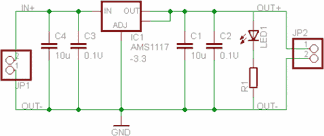thakshak wrote:mano1979 wrote:With all do respect,
Why is that nodemcu board better?
Waiting for it to arrive from china takes more than 30 days to most countries.
My board costs less than 10 dollars incl. the esp module.
For most makers, making your own singlesided pcb is a matter of 20 minutes. And no struggle at all. It all depens on your skills...
i'm a beginner.. pls bear with me..
why u use 100uF tantalum capacitors in-out to LDO
in other circuits i have seen someone using in-100uF and out-1000uF,
another using two capacitors(ceramic) to in and out of LDO as shown in below image...
another in-4.7uF and out-10uF,
is there any difference between types(tantalum ceramic electrolytic etc) of caps we use...?
and what values of caps are best to use for esp-12..?
thanks..
Decoupling capas is not an accurate science, one usually goes by "rule of thumb". It is common to combine a 10 uF electrolyte and a 100 nF ceramic capa because the frequency response of the two types is different. The electrolytes take care of low frequency noise while the ceramics have better high frequency response. The ceramic should be as close to the consumer as possible, while the electrolyte is usually placed in a starpoint, where the voltage enters the board / module.
